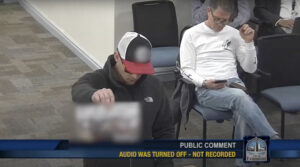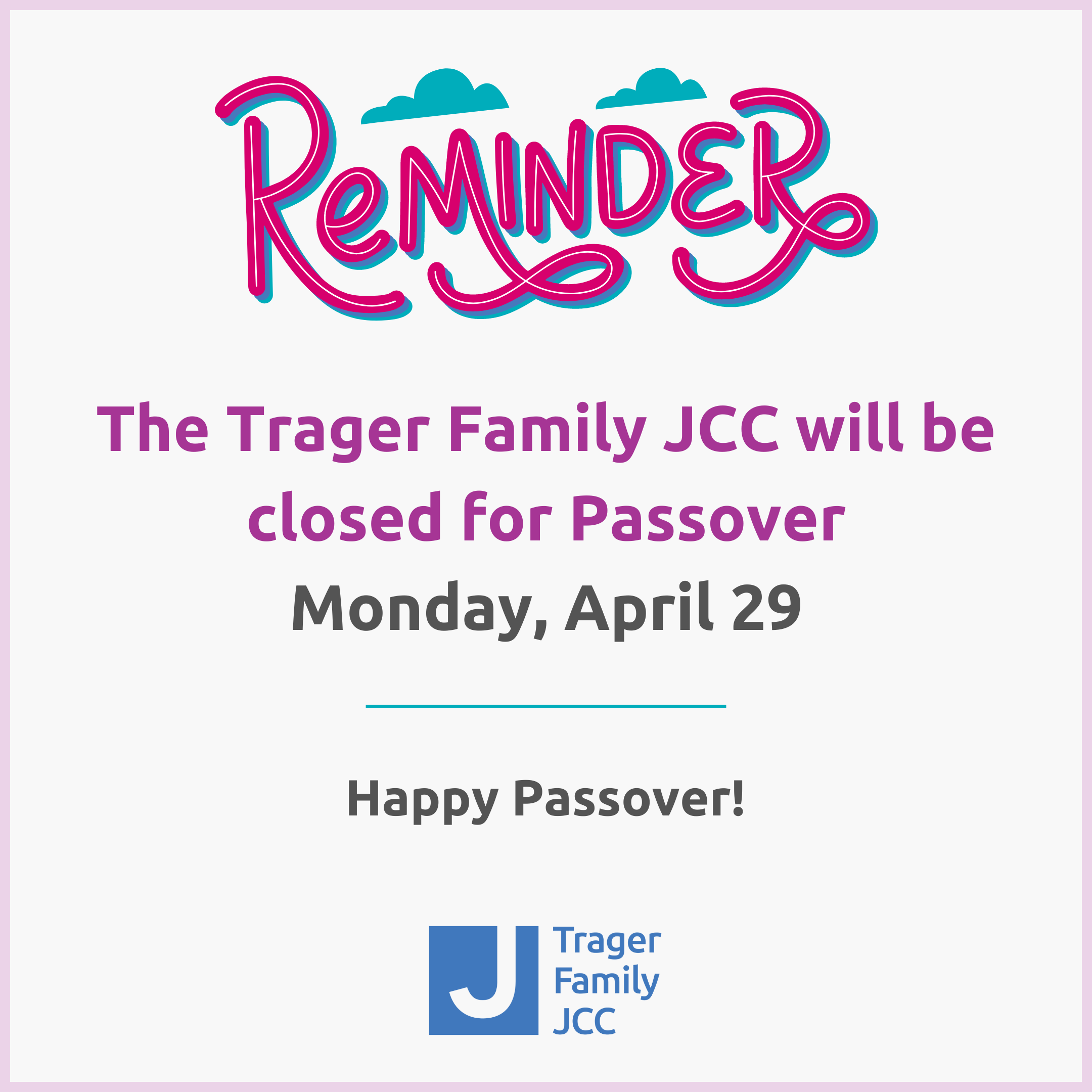By Andrew Lapin

A neo-Nazi speaker is blurred out and his microphone is cut off as he speaks during a city council meeting in Evanston, Illinois, Feb. 22, 2024. (Screenshot via YouTube)
(JTA) – At a recent city council meeting in Evanston, Illinois, a man in dark sunglasses stepped up to the podium during the public comment period to accuse the Anti-Defamation League of stifling free speech.
Wearing a hat with the logo of the neo-Nazi group Goyim Defense League, the man — who claimed to be a local resident — held up what he said was an “ADL toolkit that was sent to city councils across this nation.”
It was a line that simultaneously alluded to pro-Palestinian rhetoric about Jewish and pro-Israel groups working in tandem with council members to shut down calls for ceasefires in the Israel-Hamas war. It also hearkened to much older antisemitic thinking about Jews controlling governments and institutions.
He was swiftly cut off from speaking by the city’s progressive Jewish mayor, Daniel Biss, and both his hat and handout were blurred in video of the Feb. 22 meeting posted online. But he wasn’t the only white supremacist who spoke that night: Others made antisemitic remarks via Zoom as part of a coordinated campaign, some going after Biss directly.
The events of that evening prompted Biss and the council to consider new rules that would limit who could speak at such meetings in the future. At a follow-up meeting days later, the mayor called the public comment period “truly horrifying.”
“Are they coming back? Is this the new normal?” Biss wondered in an interview with the Jewish Telegraphic Agency. He added that it would be disastrous “if city council meetings just become white nationalist and neo-Nazi demonstration sites.”
According to watchdogs, that’s exactly what’s happening. This kind of openly antisemitic demonstration during a public meeting is a part of white supremacist strategy that predates the outbreak of the Israel-Hamas war on Oct. 7 by a few months — the GDL calls it their “City Council Death Squad.”
But the Evanston scene is also emblematic of an uncomfortable new reality: White supremacist activity targeting Jews has ticked up sharply in the months since the war in Israel and Gaza began, and it shows no signs of dissipating. What’s more, watchdogs say, white supremacists are also capitalizing on widespread anti-Israel rhetoric to find quarter in public meetings and protests.
While much public attention has been devoted to the reported rise of antisemitism in pro-Palestinian and progressive spaces during the past five months, researchers and analysts say those who care about anti-Jewish bigotry need to keep their eyes on the far right, too.
“When the war first started we saw an immediate reaction from white supremacist leaders,” Carla Hill, senior director of investigative research for the ADL’s Center on Extremism, told JTA. Hill said the common refrain was one of “applauding Hamas and even celebrating the deaths of Jews at the hands of Hamas.”
Researchers who track extremist activity online told JTA that violent threats specifically directed at Jews, on unmoderated social networks popular with white supremacists like 4Chan, Telegram and Odysee, shot up after the Hamas attacks and have remained high ever since.
“It literally is a new normal. There’s just far more violent antisemitism on these platforms than we’ve ever seen before,” said Heidi Beirich, co-founder of the Global Project Against Hate and Extremism.
Beirich’s research tracks the movements of extremist groups, including online violent threats directed at marginalized communities, and works closely with the ADL to monitor antisemitism. She said there was a 500% spike in antisemitic threats in the 24-hour period after Oct. 7; by November, that volume was still higher than pre-Oct. 7 levels. Threats of violent antisemitism remain high on these platforms today, she said.
In addition, the ADL says, white supremacist activity in physical locations, including city council meetings and rallies, has quickly adapted to incorporate pro-Palestinian rhetoric. The Goyim Defense League has distributed “Free Palestine” flyers at rallies in Pittsburgh and other locations. The fliers aim to attract a broader audience by omitting any obviously antisemitic language and directing attendees to the neo-Nazi group’s website.
“They’re definitely seizing an opportunity. That’s what extremists do,” Hill said. “They’ll use anything like that to get their foot into a conversation.”
The GDL, whose members appeared in Evanston, has been active for the past few years. Prior to Oct. 7, their members frequently distributed antisemitic flyers throughout various communities and hung banners to capitalize on antisemitic comments in the media by the rapper Ye, formerly known as Kanye West. “Active clubs,” neo-Nazi groups that also stage public demonstrations, were forming prior to Oct. 7 but have also have been on the rise since, with recent demonstrations in Ohio and Tennessee.
Hill said the groups’ public comments at city councils will often strategically begin with pro-Palestinian talking points, taking advantage of a growing movement to push local governments to adapt ceasefire resolutions, before veering into explicit antisemitism.
Despite media reports suggesting that such tactics have infiltrated the pro-Palestinian movement on a widespread scale, Hill said she hasn’t been able to determine any evidence to that effect. But she emphasized that white supremacists also hate Muslims, Arabs and Palestinians: “Those guys hate any people of color,” she said.
A white supremacist demonstration outside a synagogue in Missoula, Montana, weeks after Oct. 7, was quickly followed by a clash with nearby pro-Palestinian demonstrators. Yet GDL leader Jon Minadeo Jr. has emphasized in his communications to followers that, while the group opposes all minority groups, getting rid of Jews is its first priority.
The Jewish pro-Palestinian group IfNotNow — which is harshly critical of Israel and has accused it of genocide in Gaza since the days immediately following Hamas’ Oct. 7 invasion — cautioned other activists not to engage with far-right advocacy for Palestinians.
“Nazis are trying to take advantage of this moment to redirect sympathy for Palestinians towards antisemitic conspiracy,” the group posted online in November. “We are unflinching: antisemitism is wrong, it is unacceptable, and it has no place in any struggle for liberation.”
The uptick in right-wing antisemitism is occurring as the mainstream Jewish community has voiced particular concern about a rise in antisemitism among the pro-Palestinian left. A study published last week by the ADL’s Center for Antisemitism Research seemed to bear this out, finding a correlation between antisemitic attitudes and certain pro-Palestinian beliefs like the idea that Israeli products should be boycotted and that “Israeli operatives are secretly manipulating US national policy.” It also reported that millennials are likelier to embrace antisemitic tropes than older generations.
ADL CEO Jonathan Greenblatt has also recently pushed the idea that left-wing anti-Zionism is just as dangerous for Jews as right-wing antisemitism, and he has repeatedly condemned IfNotNow and its frequent partner Jewish Voice for Peace, an anti-Zionist group. (He also drew criticism this week for presenting an award to Jared Kushner, the Jewish son-in-law and former advisor to ex-President Donald Trump, who has himself drawn criticism from across the ideological spectrum over his repeated reluctance to condemn white supremacists.)
But Beirich said the far right still represents the much bigger threat to Jewish safety. Even amid recent reported incidents of left-wing protesters violently targeting Jewish and pro-Israel people, she said the substantial majority of violent antisemitic attacks have originated from the right. She added that the possibility of a second Trump presidency — which gained likelihood this week as he effectively clinched the Republican nominating contest — could exacerbate that threat.
“I do think a second Trump term, if it happens to occur, is going to further animate these bad actors on the far right, just like the first one did,” Beirich said.
Far-right attacks such as the 2018 Pittsburgh synagogue shooting and the deadly Charlottesville neo-Nazi march, both of which occurred under Trump’s watch, could have another uptick if Trump re-entered the White House, she said. The Pittsburgh shooter was an active user of Gab, a social network popular among extremists that is similar to the ones where antisemitic sentiment is buzzing today.
But while there is broad recognition of the need to address far-right antisemitic activity, Biss told JTA that there is a limit to how much city councils like his can restrict the right to public comment. The next Evanston council meeting, on Monday, will include a discussion of possible ways the body can change its proceedings around comment period; that discussion may also, he warned, attract more white supremacists.
He’s still determined to try to change the process. At the meeting following the one targeted by the GDL, Biss elaborated on his decision to cut off public comment early by invoking his Holocaust-survivor grandmother.
“They started with rhetoric about, conspiracies about, how every single problem a person might have was a result of the Jews controlling the world,” Biss said about the Nazis. “They started with vandalism and graffiti and isolated attacks on the street, and Jews not feeling safe being out in public and true to who they were. And it accelerated and accelerated to a point that we all know a lot about.
“The folks who participated in public comment on Thursday, they were kooks, they were provocateurs and trolls,” he continued. “But they were also vectors for the most damaging virus that we have experienced as a people.’




